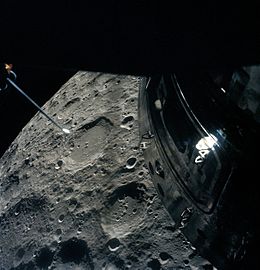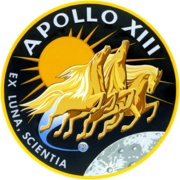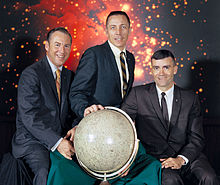Apollo 13
 The Apollo 13 crew took this photo of the Moon from theLunar Module. | |
| Mission type | Crewed lunar landing attempt |
|---|---|
| Operator | NASA[1] |
| COSPAR ID | 1970-029A |
| SATCATno. | 4371 |
| Mission duration | 5 days, 22 hours, 54 minutes, 41 seconds |
| Spacecraft properties | |
| Spacecraft |
|
| Manufacturer | |
| Launch mass | 101,261 pounds (45,931 kg) |
| Landing mass | 11,133 pounds (5,050 kg) |
| Crew | |
| Crew size | 3 |
| Members | |
| Callsign |
|
| Start of mission | |
| Launch date | April 11, 1970, 19:13:00UTC |
| Rocket | Saturn VSA-508 |
| Launch site | KennedyLC-39A |
| End of mission | |
| Recovered by | USSIwo Jima |
| Landing date | April 17, 1970, 18:07:41UTC |
| Landing site | South Pacific Ocean 21°38′24″S165°21′42″W/ 21.64000°S 165.36167°W |
| Orbital parameters | |
| Reference system | Geocentric |
| Regime | Cislunar |
| Flyby of Moon(orbit and landing aborted) | |
| Closest approach | April 15, 1970, 00:21:00 UTC |
| Distance | 254 kilometers (137 nmi) |
| Docking with LM | |
| Docking date | April 11, 1970, 22:32:08 UTC |
| Undocking date | April 17, 1970, 16:43:00 UTC |

 Left to right Lovell, Swigert, Haise, 12 days after their return. | |
Apollo 13was the seventh mission ofNASA'sProject Apollo.It was the third lunar-lander mission with a crew.Jim Lovellcommanded Apollo 13. The other astronauts wereJack SwigertandFred Haise.
The craft launched successfully toward theMoon,but two days after launch a faulty oxygen tank exploded. It damaged theService Module.It lost oxygen and electrical power. There was a very large chance that the astronauts would die before they could return to Earth. They were very short onoxygen.Oxygen is not just used to breathe; on the Apollo spacecraft it was used in a device called aFuel cellto generate electricity. So they saved their remaining air by turning off almost all their electrical equipment, for example heaters. It became very cold in thespacecraft.
The astronauts also had to move into theApollo Lunar Moduleto survive and use it as lifeboat.
When they approached the Earth they were not sure that theirparachutes,needed to slow theCommand Moduledown, would work. The parachutes were thrown out by smallexplosivecharges that were fired bybatteries.The cold could have made the batteries fail, so the parachutes would not work and the Command Module would hit the ocean so fast that all aboard would be killed.
The flight[change|change source]
Apollo 13 launched on April 11, 1970 at 19:13UTCfromCape Canaveraland went into temporarylow Earth orbit.Two hours later they fired the rocket motor again to go towards the Moon. They wanted to land atFra Mauro.Despite the hardships, the crew made it back to Earth. Though the crew did not land on the Moon, the flight became very well known.
Some people thought it was a failure because they did not land on the Moon. However, others thought it was possibly theNational Aeronautics and Space Administrations' (NASA's)greatestaccomplishment in returning three men in a very damaged spacecraft back to Earth safely.
Coming up to re-entry, it was thought that the electrical equipment would short circuit because the water in the astronauts' breath had turned back into a liquid all over the computers. However, the electronics were fine.
Books were written about the event, for example one by Jim Lovell, the commander of the mission. Amoviewas also made about it, directed byRon Howardand starringTom Hanks.
Related pages[change|change source]
References[change|change source]
- ↑Orloff, Richard W. (September 2004) [First published 2000]."Table of Contents".Apollo by the Numbers: A Statistical Reference.NASA History Series. Washington, D.C.:NASA.ISBN0-16-050631-X.LCCN00061677.NASA SP-2000-4029.RetrievedApril 15,2012.
{{cite book}}:|work=ignored (help)
Other websites[change|change source]
![]() Media related toApollo 13at Wikimedia Commons
Media related toApollo 13at Wikimedia Commons
